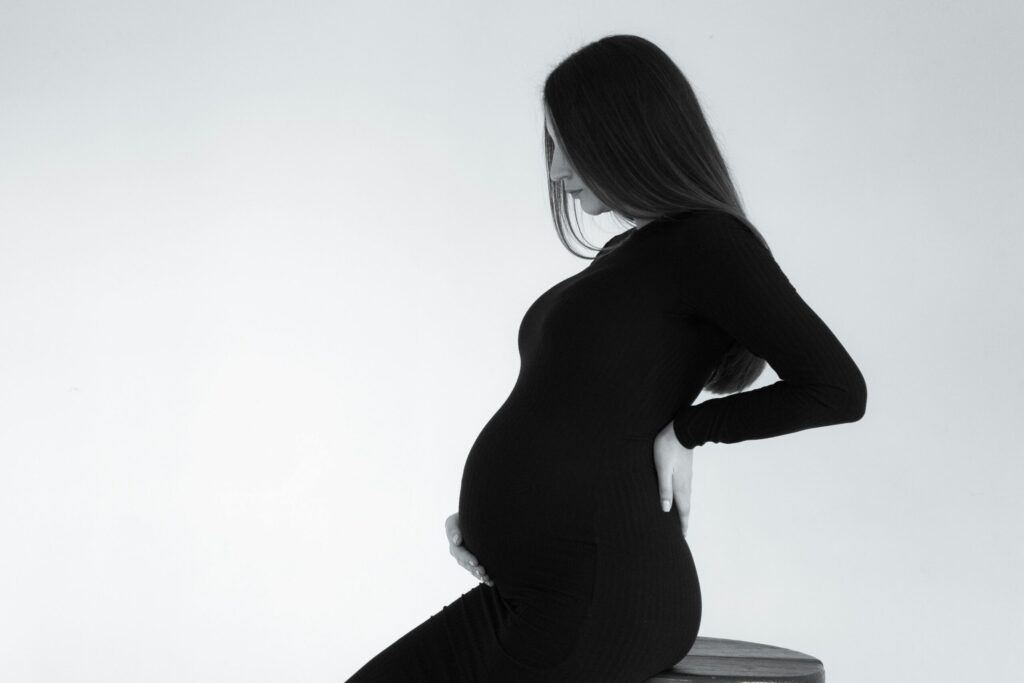The second trimester is often called the “honeymoon phase” of pregnancy—morning sickness subsides, energy returns, and you’re not yet carrying the full weight of a third-trimester belly. However, for many expectant mothers, this period introduces a new challenge: pregnancy back pain relief becomes a daily necessity. As both a mother who’s carried five children and a midwife who’s supported thousands of women through pregnancy, I can tell you that back pain is one of the most common complaints I hear—and thankfully, one of the most manageable with the right approach.
Why Back Pain Occurs During the Second Trimester
Your body undergoes remarkable changes to accommodate your growing baby. By the second trimester, these changes can significantly impact your back.
The Perfect Storm for Back Discomfort
When I was pregnant with my twins (babies #3 and #4), I remember waking up one morning around week 18 and feeling like someone had replaced my spine with a rusty hinge. This sudden onset of back pain catches many women by surprise, but physiologically, it makes perfect sense. Several factors converge during the second trimester to create ideal conditions for back discomfort:
- Your growing uterus shifts your center of gravity forward, forcing your posture to adjust
- Hormonal changes, particularly the release of relaxin, loosen the ligaments that stabilize your joints
- Weight gain, even within healthy ranges, puts additional pressure on your spine
- Separation of abdominal muscles (diastasis recti) can reduce core support for your back
As your belly grows, your lower back curves more deeply (lordosis), your shoulders may round forward, and your pelvis might tilt anteriorly—all adjustments that can strain the muscles supporting your spine.
Types of Back Pain in Pregnancy
Not all pregnancy back pain relief needs are the same, as different women experience different types of discomfort:
- Lower back pain is most common, characterized by a dull ache or sharp pain in the lumbar region
- Posterior pelvic pain includes discomfort in the buttocks, back of thighs, and across the tailbone
- Sciatica occurs when the sciatic nerve is compressed, causing shooting pain down one leg
- Upper back and neck tension often develops as breast size increases and posture changes
One mother in my practice described her second-trimester back pain as “feeling like I’ve been horseback riding for hours, even though I’ve just been sitting at my desk.” Another likened it to “carrying a backpack that keeps getting heavier, but you can never take it off.” These descriptions might resonate with what you’re experiencing.
Everyday Strategies for Pregnancy Back Pain Relief
The good news is that you don’t have to simply endure back pain as an inevitable part of pregnancy. Throughout my years of practice and personal experience, I’ve found several approaches that provide significant relief.
Posture Adjustments That Make a Difference
Your mother was right—posture matters, especially during pregnancy! When I was carrying my fifth baby, I noticed I could dramatically reduce my back discomfort simply by being mindful of how I stood and sat.
When standing:
- Keep your chest lifted and shoulders relaxed
- Tuck your buttocks under slightly to avoid overarching your lower back
- Place one foot on a low stool when standing for long periods
- Wear supportive shoes (sorry, but those cute heels may need a temporary retirement!)
When sitting:
- Choose chairs with good back support, or use a small pillow behind your lower back
- Keep your feet flat on the floor or elevated on a footrest
- Avoid crossing your legs, which can throw your pelvis out of alignment
- Take regular breaks—I recommend standing up at least every 30 minutes
According to the American Pregnancy Association, proper posture during pregnancy not only reduces back pain but can also help with other common discomforts like heartburn and shortness of breath.
Supportive Gear Worth Investing In
Some pregnancy products are merely nice-to-have, but when it comes to pregnancy back pain relief, certain items can be game-changers:
Maternity support belts provide gentle compression and lift for your growing belly, taking pressure off your lower back. I remember being skeptical about these with my first pregnancy until a colleague insisted I try hers during a long shift. The difference was so dramatic that I bought my own that evening!
Pregnancy pillows help maintain proper alignment while sleeping. The full-body “C” or “U” shaped pillows are particularly helpful for side-sleeping, which becomes necessary as pregnancy progresses.
Proper footwear with arch support and cushioning redistributes weight more evenly and promotes better posture. One mother in my practice, a kindergarten teacher who stood most of the day, said switching to supportive shoes reduced her back pain by about 70%.
Ergonomic chair modifications for work or home can make a significant difference if you sit for extended periods. Lumbar supports or seat wedges that promote proper pelvic positioning are worth considering.
Movement as Medicine for Back Pain
In my two decades as a midwife, I’ve observed that the women who maintain appropriate physical activity throughout pregnancy typically experience less severe back pain.
Safe Exercises for the Second Trimester
The right exercises strengthen the muscles that support your spine while increasing flexibility. Here are some pregnancy back pain relief exercises that have benefited many expectant mothers:
Pelvic tilts strengthen abdominal muscles and relieve lower back tension. Standing with your back against a wall or on all fours, gently rock your pelvis back and forth to flatten and arch your lower back alternately.
Cat-cow stretches increase spine mobility. On hands and knees, alternate between arching your back (like a cat) and letting your belly sink toward the floor (like a cow).
Swimming provides excellent full-body exercise without putting pressure on your joints. The buoyancy of water temporarily relieves the weight of pregnancy while allowing you to strengthen supporting muscles.
Prenatal yoga combines strength, flexibility, and relaxation techniques specifically designed for pregnant bodies. I still remember the sense of relief I felt in child’s pose during my third pregnancy—it was like someone had temporarily lifted the weight of my belly and allowed my back to reset.
A review published in the Journal of Physiotherapy found that exercise during pregnancy significantly reduces the intensity of lower back and pelvic pain compared to standard care alone.
The Importance of Rest and Recovery
While movement is crucial, so is appropriate rest. Finding the balance between activity and recovery becomes especially important during pregnancy.
I advise my patients to listen to their bodies—pregnancy is not the time to push through pain. If an activity increases your discomfort, modify or substitute it. Alternating periods of movement with rest gives your muscles time to recover.
One helpful technique is the side-lying position with pillows between your knees and under your belly. This position takes pressure off your spine while maintaining proper alignment. Many women find this position so comfortable that they adopt it for sleeping throughout pregnancy.
Hands-On Approaches to Managing Back Pain
Sometimes, direct intervention provides the most immediate pregnancy back pain relief.
Massage and Gentle Stretching
Regular massage can work wonders for pregnancy-related back pain. Whether performed by a professional massage therapist familiar with pregnancy or by a willing partner, massage increases circulation, reduces muscle tension, and promotes relaxation.
I remember teaching my husband a simple lower back massage technique during my first pregnancy. It became our evening ritual—10 minutes that made the difference between a restless night and restful sleep. Here’s a simple technique you can teach your partner:
- Sit comfortably with support for your back
- Have your partner place their thumbs on either side of your spine (not directly on it)
- Apply gentle pressure and make small circular motions, working from the middle of the back downward
- Focus on the dimples just above the buttocks, where many women hold tension
Gentle stretching, especially of the hamstrings, hip flexors, and lower back, can prevent muscles from becoming tight and painful. Remember to move slowly into stretches without bouncing, and never stretch to the point of pain.
Heat and Cold Therapy
Applying heat to sore areas increases blood flow and relaxes tight muscles. A warm (not hot) shower directed at your back, a heating pad on a low setting, or a microwavable heat pack can provide significant relief.
Cold therapy reduces inflammation and numbs pain. Some women find that alternating between heat and cold provides the best results. I recommend 15 minutes of heat followed by 15 minutes of cold, with a 15-minute break in between.
One creative mother in my practice made her own flexible cold packs by dampening kitchen towels, placing them in ziplock bags, and freezing them. She could then mold these around her lower back while sitting.
Professional Help for Persistent Back Pain
While most pregnancy back pain responds well to self-care measures, sometimes professional intervention is warranted.
When to Consult Your Healthcare Provider
Seek guidance from your midwife, obstetrician, or primary care provider if:
- Back pain is severe or suddenly worsens
- Pain radiates down your leg(s) below the knee
- You experience numbness or weakness
- The pain is accompanied by fever, burning urination, or vaginal bleeding
- The pain interferes significantly with daily activities or sleep
These symptoms could indicate conditions requiring specific treatment beyond general pregnancy back pain relief measures.
Safe Professional Treatments During Pregnancy
Several professional treatments can safely provide relief during pregnancy:
Physical therapy offers targeted exercises and manual techniques specific to your needs. A physical therapist can also evaluate your posture and movement patterns, suggesting personalized modifications.
Chiropractic care from providers experienced in treating pregnant women can help maintain proper alignment. The Webster Technique, specifically designed for pregnancy, focuses on balancing the pelvis and reducing pressure on the lower back.
Acupuncture has shown promising results for pregnancy-related back pain. One study found that pregnant women receiving acupuncture reported greater pain reduction than those receiving standard care alone.
Prenatal osteopathy uses gentle manipulative techniques to support the body’s natural alignment as it changes through pregnancy.
Always ensure any practitioner you see is experienced in treating pregnant women and communicate with your primary prenatal care provider about additional treatments you’re receiving.
Preventing Back Pain Before It Starts
While not all back pain can be prevented, proactive measures can minimize its severity.
Daily Habits That Protect Your Back

Core-strengthening exercises before and during early pregnancy create a stronger foundation. Focus on deep abdominal muscles and pelvic floor exercises (Kegels), which provide internal support for your spine.
Proper lifting technique becomes increasingly important as pregnancy progresses. Bend at the knees, not the waist, keep objects close to your body, and avoid twisting while lifting.
Regular position changes prevent muscles from becoming stiff and sore. Even if you’re comfortable, try to change positions every 30 minutes.
Stress management reduces muscle tension that can contribute to back pain. Pregnancy can be emotionally and physically demanding—finding healthy ways to manage stress protects both mental and physical well-being.
Embracing This Season of Change
As both a midwife and mother, I’ve come to see pregnancy discomforts, including back pain, as meaningful reminders of the incredible work our bodies are doing. Each twinge is evidence of your body making space for new life—a temporary challenge with the most permanent and precious reward.
When I was struggling with back pain during my fourth pregnancy, an older midwife shared wisdom I’ve never forgotten: “Your body isn’t failing you—it’s succeeding at something extraordinary.” That perspective helped me approach pain management not from frustration but from a place of partnership with my changing body.
The second trimester brings many changes, and finding effective pregnancy back pain relief strategies will allow you to focus more on the joy of this special time and less on discomfort. Remember that each pregnancy is unique—what works for one woman might not work for another, and what worked in your previous pregnancy might not be as effective this time around.
Be patient with yourself as you discover what brings you relief, and don’t hesitate to ask for help from your healthcare providers, partner, family, and friends. This season of back pain is temporary, but the life growing within you is creating a permanent change in your family that makes it all worthwhile.



